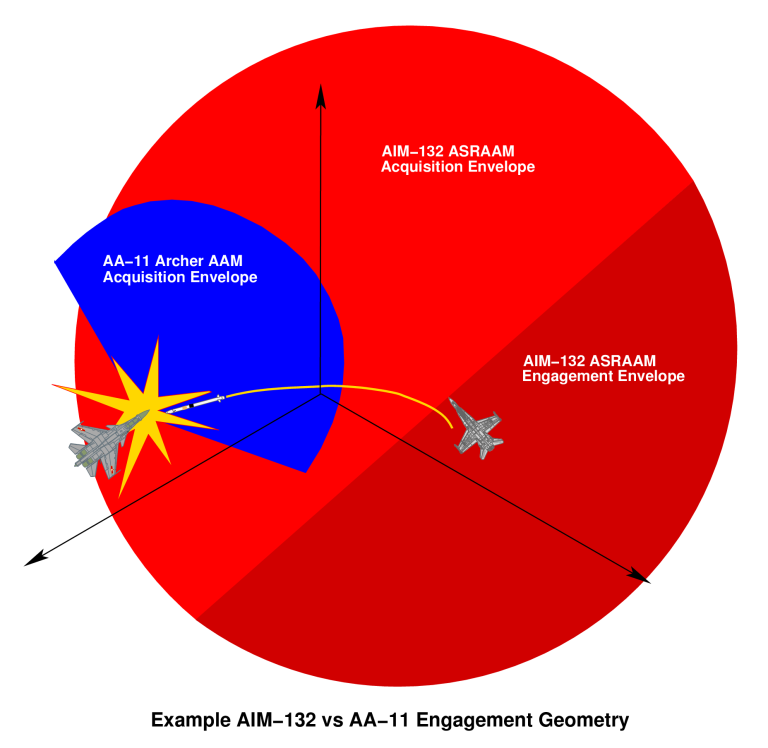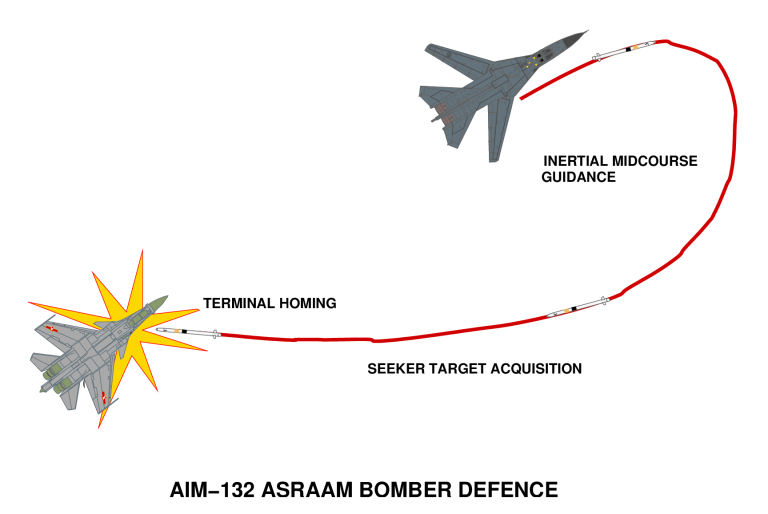The ASRAAM (Advanced Short Range Air-to-Air Missile), also known by its United States identifier AIM-132, is the next generation infrared-guided, an imaging infrared homing ("heat seeking") air-to-air missile designed and built by MBDA UK (formerly Matra BAe Dynamics) to provide enhanced aerial combat capabilities for fighter aircraft. It is currently in service in the Royal Air Force (RAF) and Royal Australian Air Force (RAAF), replacing the AIM-9 Sidewinder. ASRAAM is designed to outrange and outrun any other IR missile in service, allowing the pilot to fire and then turn away long before the opposing aircraft can close for a shot.
It flies at well over Mach 3 to ranges as great as 50 kilometres (31 mi), well over double the range of earlier designs. It retains a 50g manoeuvrability provided by body lift technology coupled with tail control.
The air combat missile was deployed by the UK Royal Air Force (RAF) during the Gulf conflict in 2003. It was integrated onto the RAF's Eurofighter Typhoon and Tornado GR4 aircraft under Operation Unified Protector. The missile is also in service with the Royal Australian Air Force (RAAF) aboard F/A-18 Hornet fighter aircraft. It will also be fixed to the RAF's F-35 Lightning II Joint Strike Fighter (JSF) aircraft.
Development of ASRAAM
In 1980, a joint U.S./European agreement for development of a new family of air-to-air weapons was signed. This agreement put the responsibility for the BVR (Beyond Visual Range) AMRAAM (Advanced Medium-Range Air-to-Air Missile) to the United States (leading to the AIM-120), while the complementary ASRAAM "dogfight missile" would be developed in Europe. After a joint British/German/Norwegian project definition phase between 1984 and 1987, it was decided to proceed with the development of the ASRAAM. The U.S. missile designation YAIM-132A was allocated to the forthcoming ASRAAM prototypes, although the U.S. military was not satisfied with the results of the definition phase. The AIM-132 was to be developed by a joint venture of the British company BAe Dynamics and the German BGT (Bodensee Gerätetechnik). In March 1989 the design was finalized but a few months later Germany pulled out of the program because of different requirements. While the UK put emphasis on high velocity and increased range, Germany insisted on a dogfight-optimized missile with extreme manoeuverability using TVC (Thrust-Vectoring Control) (this requirement eventually led to the IRIS-T missile development program). To make things worse, the other ASRAAM partners (USA, Canada, Norway) pulled out of the program in 1990, too.
In May 1991 the UK requested proposals from the industry for a new short-range air-to-air missile. Several companies submitted their designs, and in March 1992 a development contract for the ASRAAM was finally awarded to BAe Dynamics. In January 1995 British Aerospace Dynamics, Stevenage, Hertfordshire, England, was awarded a letter contract with a ceiling amount of $10,933,154 for foreign comparative testing [FCT] of the ASRAAM Missile. The purpose of the testing is to gather data to determine if the missile meets AIM-9X operational requirements. Work was performed in Stevenage, Hertfordshire, England (50%), Eglin Air Force Base, Florida (25%), and China Lake, California (25%), and was completed by June 1996. The tests focused on the risk areas of the ASRAAM: focal plane array effectiveness, seeker signal processing, warhead effectiveness, rocket motor testing, and kinematic/guidance ability to support the lethality requirements of the AIM-9X. After several modifications to the scope of the FCT, the program assessed four ground-to-air sorties, 19 air-to-air captive carry sorties, four programmed missile launches, eight static warhead tests, and four rocket motor case tests. The resulting assessment was that the ASRAAM (as is) could not meet the AIM-9X operational requirements in high off-boresight angle performance, infrared counter-countermeasures robustness, lethality, and interoperability. Subsequently, Hughes and BAe proposed an improved "P3I ASRAAM" using thrust-vectoring to provide increased agility and to carry a heavier warhead. In February 1998 the ASRAAM gained its first international customer, when Australia selected the missile to arm its F/A-18 Hornet aircraft. In December 1998 the first ASRAAM missiles were delivered to the RAF for systems integration. The first missiles should be delivered between 1999 and the year 2000.
ASRAAM design and features
The ASRAAM air-to-air missile can outperform all existing short-range missiles in close-in combat missions. It features low-drag design concept incorporating body lift technology.
The tail-controlled missile measures 2.9m in length, 166mm in diameter and 88kg in weight. It is fitted with high-explosive blast fragmentation warhead with impact and laser proximity fuses. The missile is also equipped with seeker detector cooling and self contained cooling engine.
The missile can be deployed using lock before launch capability to engage targets in the forward hemisphere. It can be launched in 'lock after launch' mode to engage targets beyond the seeker acquisition range.
The missile gathers target positional data from aircraft sensors including radar or helmet mounted sight during close-in combat missions when target is located outside the off-boresight and visual limits of seeker. This capability ensures the aircraft's crew to perform over-the-shoulder firing in 'lock after launch' mode.
Missile guidance and sensors
The ASRAAM weapon is guided by an advanced, accurate focal plane array Imaging Infra-Red (IIR) seeker developed by Raytheon. The passive homing guidance system provides the ability to significantly track, acquire and engage targets beyond visual range (BVR) under severe clutter and countermeasures environmental situations.
The missile collects the target data using fibre optic gyro sensors and solid state accelerometers, stabilised in three axes. It can also gather target information from autonomous infrared search and track system.
Propulsion for the short range air-to-air missile
The missile's REMUS powerplant is unique in several respects. Manufactured by Royal Ordnance, Summerfield, the motor uses a proprietary strip steel laminate casing, rather than a conventional machined tubular casing. The laminated casing is stiffer, lighter, and much more tolerant of physical mishandling or shrapnel/spall/bullet damage in comparison with conventional designs. The casing forms a combustion chamber which exhausts through a blast tube and fixed geometry nozzle. With a 6.5" external diameter, the motor contains roughly 70% more propellant per unit length in comparison with the established Mk.36 Sidewinder motor. Using a low smoke, low flame propellant, the motor is designed with a boost only burn profile. As a result, the missile exhibits arguably the best kinematic performance of any contemporary WVR missile design.
The missile is controlled by a high torque servo package driving four independent tail surfaces. The Lucas Aerospace actuator package is wrapped around the exhaust blast tube.
Specifications
Missile Type
Air-to-air missile
Manufacturer
MBDA UK
Weight 88 kg
Length 2.90 m
Diameter 166 mm (motor diameter)
Warhead 10 kg blast/fragmentation
Detonation mechanism
laser proximity fuze and impact
Engine
dual-burn, high-impulse solid rocket motor
Wingspan
450 mm
Operational range
300 m – 50 km
Flight altitude N/A
Speed
Mach 3+
Guidance system
infrared homing, 128×128 element focal plane array, with lock-on after launch (LOAL) and strapdown inertial guidance
Launch platform Aircraft:
Royal Air Force: Tornado, Typhoon
Royal Australian Air Force: F/A-18


